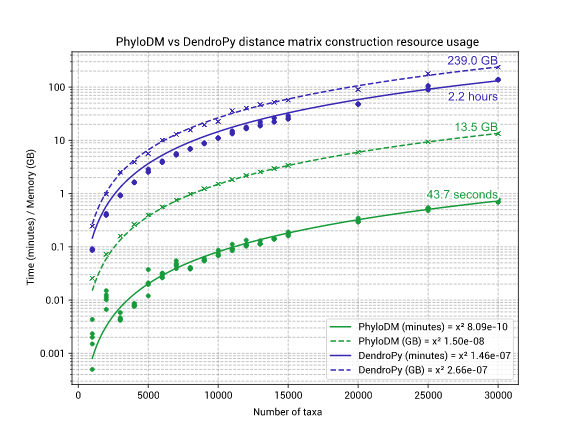10 stable releases
| 3.2.0 | Oct 8, 2024 |
|---|---|
| 3.1.0 | Jul 16, 2024 |
| 3.0.0 | Jun 17, 2023 |
| 2.2.1 | Jan 9, 2023 |
| 2.0.0 | May 3, 2022 |
#220 in Math
545 downloads per month
140KB
1.5K
SLoC
🌲 PhyloDM
PhyloDM is a high-performance library that converts a phylogenetic tree into a pairwise distance matrix.
For a tree with 30,000 taxa, PhyloDM will use:
- ~14GB of memory (94% less than DendroPy)
- ~1 minute of CPU time (183x faster than DendroPy).
PhyloDM is written in Rust and is exposed to Python via the Python PyO3 API. This means it can be used in either Python or Rust, however, the documentation below is written for use in Python. For Rust documentation, see Crates.io.
⚙ Installation
Requires Python 3.9+
PyPI
Pre-compiled binaries are packaged for most 64-bit Unix platforms. If you are installing on a different platform then you will need to have Rust installed to compile the binaries.
python -m pip install phylodm
Conda
conda install -c b bioconda phylodm
🐍 Quick-start
A pairwise distance matrix can be created from either a Newick file, or DendroPy tree.
from phylodm import PhyloDM
# PREPARATION: Create a test tree
with open('/tmp/newick.tree', 'w') as fh:
fh.write('(A:4,(B:3,C:4):1);')
# 1a. From a Newick file
pdm = PhyloDM.load_from_newick_path('/tmp/newick.tree')
# 1b. From a DendroPy tree
import dendropy
tree = dendropy.Tree.get_from_path('/tmp/newick.tree', schema='newick')
pdm = PhyloDM.load_from_dendropy(tree)
# 2. Calculate the PDM
dm = pdm.dm(norm=False)
labels = pdm.taxa()
"""
/------------[4]------------ A
+
| /---------[3]--------- B
\---[1]---+
\------------[4]------------- C
labels = ('A', 'B', 'C')
dm = [[0. 8. 9.]
[8. 0. 7.]
[9. 7. 0.]]
"""
Accessing data
The dm method generates a symmetrical NumPy matrix and returns a tuple of
keys in the matrix row/column order.
# Calculate the PDM
dm = pdm.dm(norm=False)
labels = pdm.taxa()
"""
/------------[4]------------ A
+
| /---------[3]--------- B
\---[1]---+
\------------[4]------------- C
labels = ('A', 'B', 'C')
dm = [[0. 8. 9.]
[8. 0. 7.]
[9. 7. 0.]]
"""
# e.g. The following commands (equivalent) get the distance between A and B
dm[0, 1] # 8
dm[labels.index('A'), labels.index('B')] # 8
Normalisation
If the norm argument of dm is set to True, then the data will be normalised
by the sum of all edges in the tree.
⏱ Performance
Tests were executed using scripts/performance/Snakefile on an Intel(R) Xeon(R) CPU E5-2650 v3 @ 2.30GHz.
For large numbers of taxa it is beneficial to use PhyloDM, however, if you have a small number of taxa in the tree it is beneficial to use DendroPy for the great features it provides.
Dependencies
~8–15MB
~124K SLoC
